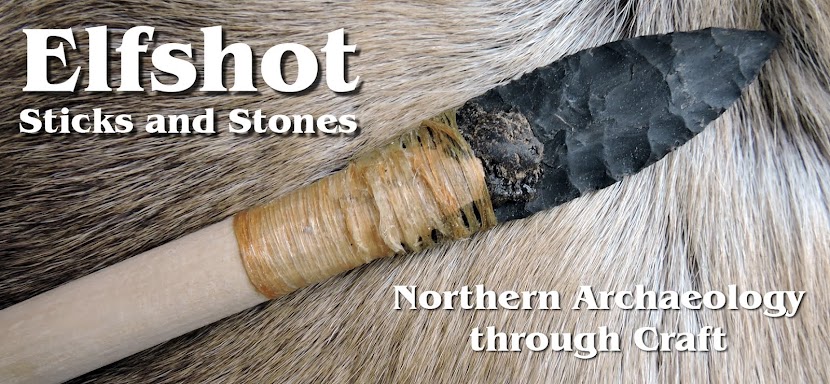 |
| Thule harpoon with whalebone socket and foreshaft |
 |
| new socket (left) broke socket (right) |
Originally, I was intending to repair the socket with some whalebone pegs, as I thought it would make an interesting reproduction. Repairs like that help antique a piece and give it a history. Which would have been fine to hang on my wall, but for a client, I want to have everything perfect and this repair is an opportunity to learn from previous mistakes. The broken socket was make on a section of sperm whale bone - part of a rib or mandible that I got years ago. Sperm whale bone is very dense, so I used a section of bone from near the edge that was primarily interior bone, with a relatively thin sheet of more dense exterior bone on one face. The crack on the socket happened at the interface between the interior and exterior bone. In the photos, you can see the dense exterior bone because its white, while the more spongy interior bone is grey. On sperm whale bone the interior bone is still pretty dense, but there is a difference between interior and surface bone.
 |
| You can see where I cut the socket out of the whale rib. For scale, the boards in the background are 5 1/4" wide and the tusk is 17" long. |
For the replacement socket, I used a section from a humpback whale rib. I cut a piece out of the middle of the rib that matched the width and thickness of the previous socket and shaped it to fit onto the wood harpoon main shaft and accept the base of the whalebone foreshaft. The advantage that this socket has over the previous socket is that it is entirely made from the dense outer bone layer. The spongy bone on the interior is what I carved out to make the socket for the wood shaft and the bone foreshaft. It should be more durable.
 |
| The new socket and ribs (left), broken socket (middle) and walrus tusk with a natural concavity in the base (right) |
Archaeologically, these socket pieces look more or less the same as the reproductions in these photos. Sometimes the holes on each end meet in the middle and form an hourglass shaped hole running through the middle of the bone or ivory tube. Some are made from whalebone and others are made from walrus ivory. Antler can work too, but there are taboos about mixing land animal parts on tools designed for sea mammal hunting. The base of a walrus tusk is naturally concave where all the nerves and pulp run into the tooth. A walrus tusk is the perfect thing to make a socket like this - its already the right size and shape and the large hollow in the base saves the carver even more work in shaping the socket. Plus, the tip of the tusk that is removed can be worked into the foreshaft. I went with whalebone on this particular reproduction, although it will be fit with a ivory harpoon head.
Photo Credits: Tim Rast.

No comments:
Post a Comment